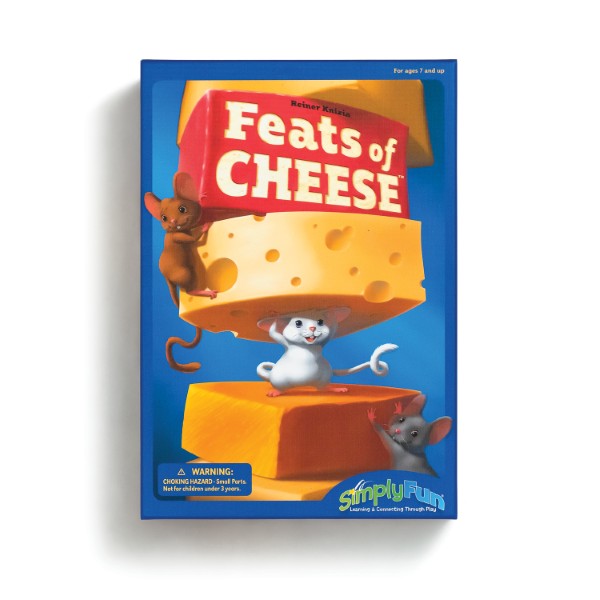
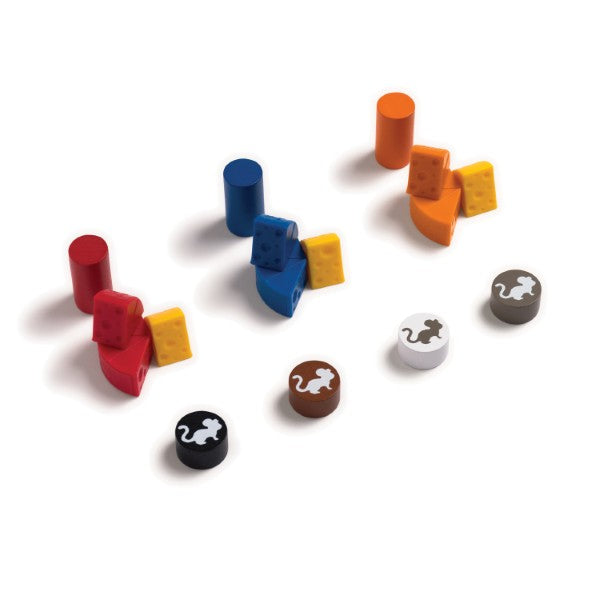
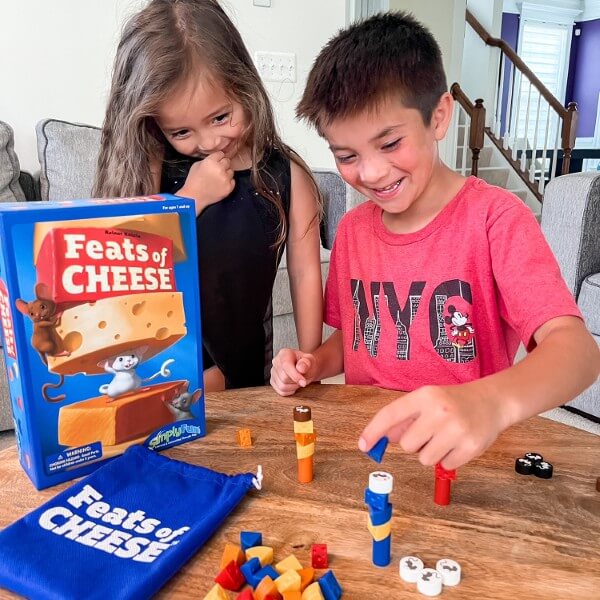
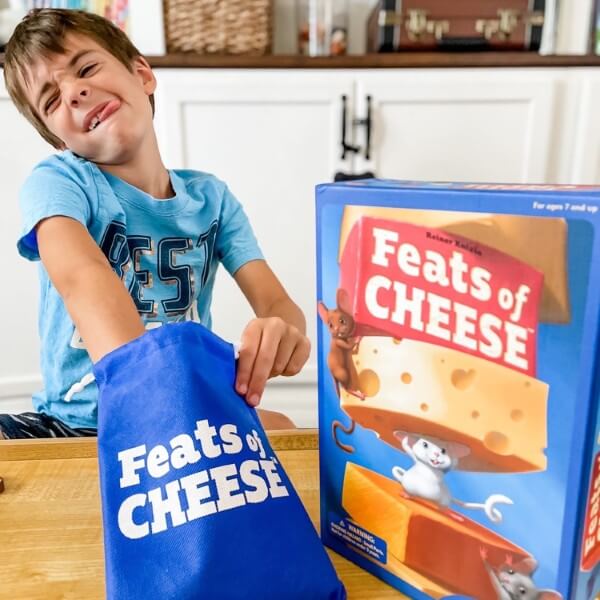
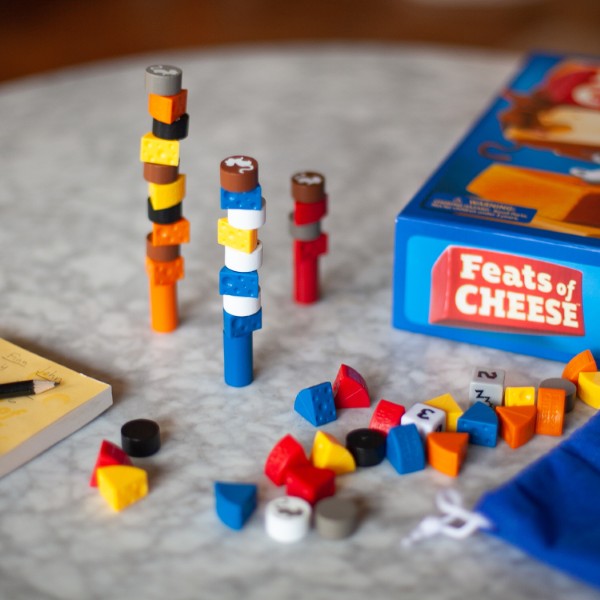

Collapsible content
Help families of mice compete for cheese by building towers stacked with wedges of cheese and mice in Simply Fun’s game of physics, Feats of Cheese! Be careful, because it takes balance and a careful hand to complete these Feats of Cheese!
You can play Feats of Cheese with 2 to 4 players ages 7 and up.
Feats of Cheese helps players learn about physics as they choose moves that make the towers either more or less stable, depending on the strategy.
Feats of Cheese also improves fine motor skills as players carefully place cheese wedges and mice onto towers of varying height and stability.
To set up Feats of Cheese, first place the three platforms in the center of the play area where players will build their towers. The platforms should be an equal distance from one another, and be at least six inches apart. The closer the platforms are to each other, the more difficult the game, as one falling tower is likely to impact the other towers.
Next, give each player four mice of the same color. If there are fewer than four players, return the extra mice to the box.
Place the bag of cheese wedges in reach of all players.
Choose a scorekeeper, and give them the score pad and pencil.
The object of Feats of Cheese is to place your cheese wedges and mice onto towers without knocking any of them down.
The player who knocks over a tower receives no points. The taller the tower is before it falls, the more points a player
may earn.
The first player to name their favorite kind of cheese goes first. Each turn has 3 steps:
Without looking, draw a cheese wedge from the bag and place it onto a platform or tower without knocking it down.
If the cheese is blue, red or orange, place it onto the matching color platform.
If the cheese is yellow, it can be placed on any tower, although it does not have any point value.
The tower must remain flat on top, so players may never place a cheese wedge pointed side up.
When placing your cheese wedge, once it touches the top of the tower you must let it go.
If you drop a cheese wedge while attempting to place it on a tower, you can try again as long as no other cheese wedges or mice fall.
After placing a cheese wedge, you may choose whether to add a mouse on top of it. If you successfully place it without knocking over the tower, your turn is over and it is the next player’s turn.
You don’t have to add a mouse if you don’t want to, but mice are how players earn points.
If all four of your mice are already placed on towers, you cannot place a mouse that turn.
If you drop your mouse while attempting to place it onto your last cheese wedge, you can try again as long as no other cheese or mice fall.
If any part of the tower falls during your turn, the other players who had mice on the towers score points.
The player who knocked over the tower or towers does not receive any points.
All other players count their points by multiplying the number of mice they had on the tower by the number of cheese wedges that match that platform’s color.
If your cheese wedge fell with the tower, it is scored with that tower and your turn is over.
If the tower fell before you placed your cheese wedge, you may place it onto the now empty platform and choose to add a mouse or not. Then your turn is over.
Every time a tower is knocked over, the scorekeeper records the points earned by each of the players.
The whole tower is included in the score, even if only part of the tower fell during gameplay.
All the mice from the fallen tower are returned to the players and can be used again.
All the cheese wedges from the fallen tower are returned to the box and removed from the game.
The platform is then replaced in the play area so a new tower of the color that fell can be built.
The game is over when the bag of cheese wedges is empty.
Players total the points on the towers that are still standing in the same way they did when the towers were knocked over. The new scores are added to that score and the total of all points is the final score. The player with the highest score wins Feats of Cheese!


Core Standard*: Math, Science
- Math
- Use place value understanding and properties of operations to perform multi-digit arithmetic.: Grade Level 4th
- Science
- In prior grades students learned to use appropriate words to describe the position and motion of objects and the effects of forces on objects. In grades 2-3 students learn that forces work not only to push and pull objects, but also affect objects when they are dropped or thrown. Whenever the motion of an object changes, there is a force involved. Greater forces on a given object result in greater changes of motion. In addition to being able to describe how forces change the motion of objects, students are expected to measure the position of objects using measuring instruments such as rulers. Students can also measure time to the nearest minute. Emphasis should be on comparisons of forces and motions rather than on calculation so that students develop conceptual understanding of how forces make things move : Grade Level 2nd, 3rd
- Number and Operations in Base Ten
- Force Makes Things Move


Explore
What Does Child Do To Use Skill In The Game?
Players need to examine the towers closely to decide where and how to stack Wedges and Mice successfully. Also, they will regularly look at the scores of other players to help determine where and what to play on their turn.
How Parents Can Assist Learning
Stacking can be tricky in Feats of Cheese because the Wedges have a raised part in the middle. This causes the stacks to tip and lean in different directions.
Parents can encourage children to look closely before playing a wedge or Mice token. This encouragement also helps children learn patience and avoid impulsivity.
Learning Implications and Educator Support
Feats of Cheese is a great game for teaching physics while building balancing, dexterity and basic strategy skills. Stacking can be tricky in Feats of Cheese because the Wedges have a raised part in the middle. This causes the stacks to tip and lean in different directions.
Educators can encourage children to look closely before playing a wedge or Mice token to help with decision-making.
Determine
What Does Child Do To Use Skill In The Game?
Players must determine where to stack a Wedge, how to orient it to minimize causing the stack to fall, and whether to place a Mice token. If a stack falls, players must add up their scores prior to continuing on with the game.
How Parents Can Assist Learning
Similar to the Explore skill, parents can encourage children to look closely before playing a wedge or Mice token. This encouragement also helps children learn patience and avoid impulsivity.
Learning Implications and Educator Support
In addition to the dexterity skills developed playing Feats of Cheese, the choice of where to play a yellow Wedge or to play a Mice token adds an element of strategy to the game.
If children play a yellow Wedge, ask them to explain why they decided to play it on a certain Platform. This helps build communication skills while giving you an opportunity to discuss and offer guidance regarding the child's strategic thinking.
Compare
What Does Child Do To Use Skill In The Game?
Players will compare relative stability of different towers, and where other players' Mice are located. Additionally, they will compare scores so they can adjust strategy to prevent players with higher scores from getting farther ahead.
How Parents Can Assist Learning
Stacking can be tricky in Feats of Cheese because the Wedges have a raised part in the middle. This causes the stacks to tip and lean in different directions.
Parents can encourage children to look closely at the stability of a stack before playing a wedge or Mice token to help with decision-making. Additionally, prompt them to think about where their and their opponents' Mice tokens are located, since scoring is based on the Mice tokens.
Learning Implications and Educator Support
Feats of Cheese is a great game for teaching physics while building balancing, dexterity and basic strategy skills. Stacking can be tricky in Feats of Cheese because the Wedges have a raised part in the middle. This causes the stacks to tip and lean in different directions.
Educators can encourage children to look closely at the stability of a stack before playing a wedge or Mice token to help with decision-making. Additionally, prompt them to think about where their and their opponents' Mice tokens are located, since scoring is based on the Mice tokens.
Remember
What Does Child Do To Use Skill In The Game?
Players may recall prior stacking techniques that increased or decreased stability.
How Parents Can Assist Learning
No special adult support required.
Learning Implications and Educator Support
No special adult support required.
Predict
What Does Child Do To Use Skill In The Game?
Playing Feats of Cheese involves predicting when a particular Platform stack is likely to fall.
How Parents Can Assist Learning
As stacks get higher, the risk of falling increases. Yet, the more of your Mice tokens on that stack increase a player's potential reward, i.e. score. Thus, Feats of Cheese is a good game for learning risk and reward skills. Parents can help children assess risk and reward by asking them to look carefully and think first before playing a Wedge and, possibly, a Mice Token. This will help the child build patience and analytical thinking skills.
Learning Implications and Educator Support
Feats of Cheese is a good game for building skills in risk and reward analysis, anticipating cause and effect, and predicting results. It is also good for building focus, self-control, and good decision-making.
Educators can help children assess risk and reward by asking open ended questions like "Are you going to play a Mice token?", "Why would you play or not a yellow Wedge on each of the platforms?" or "Which stack do you think is most likely to fall next and why?"
Plan
What Does Child Do To Use Skill In The Game?
Players uses light planning skills as they decide where to place Mice tokens, i.e. whether to put multiple on a Platform or spread them more evenly across all three Platforms.
How Parents Can Assist Learning
Parents can suggest that children try loading multiple Mice tokens on a Platform in one game, and then spreading them out in another game. This will help them learn planning skills while also assessing which strategy increases their score.
Learning Implications and Educator Support
This game involves a little planning as children try to place their Mice tokens to get the highest possible scores. Because the moves of other players can dramatically effect a child's plan, Feats of Cheese is even better for teaching flexibility and responsiveness to adapt strategy to new conditions.
Educators can suggest that children experiment with loading multiple Mice tokens on a Platform in one game, and then spreading them out in another game. This will help them learn planning skills while also assessing which strategy increases their score.
Experiment
What Does Child Do To Use Skill In The Game?
Players can experiment with putting multiple Mice tokens on a Platform or spreading them more evenly across all three Platforms.
How Parents Can Assist Learning
Like the Plan skill, parents can suggest that children experiment with loading multiple Mice tokens on a Platform in one game, and then spreading them out in another game. This will help them learn planning skills while also assessing which strategy increases their score.
Learning Implications and Educator Support
Because the moves of other players can dramatically effect a child's plan, Feats of Cheese is good teaching flexibility and responsiveness to adapt strategy to new conditions.
Educators can suggest that children experiment with loading multiple Mice tokens on a Platform in one game, and then spreading them out in another game. This will help them learn planning skills while also assessing which strategy increases their score.
Practice
What Does Child Do To Use Skill In The Game?
Feats of Cheese provides ample opportunity to practice fine motor skills.
How Parents Can Assist Learning
No special adult support required.
Learning Implications and Educator Support
No special adult support required.
Review
What Does Child Do To Use Skill In The Game?
Reviewing is not required, but players are likely to talk about what worked and what caused stacks to fall.
How Parents Can Assist Learning
Encourage children to discuss their moves and the consequences. Reviewing and reflecting help strengthen learning and build communication skills .
Learning Implications and Educator Support
Encourage children to discuss their moves and the consequences.
*Data compiled from CCSSI ELA Standards, WA Science Standards, and Washington Social Studies Standards


Cognitive
Suggestions for How to Modify Play Experience
Eliminate the yellow cheese pieces. This allows all pieces to count when the stack falls. Children with cognitive delays many not understand how one color is not worth anything.
Allow the mice token to be played before the colored cheese wedge. These tokens have flat surfaces so the cheese pieces balance better on them. This helps make the game less challenging for children.
Communication
Suggestions for How to Modify Play Experience
No communication is required. For children who need to practice talking with others, encourage them to talk about their thinking and actions after their turn.
Sensorimotor
Suggestions for How to Modify Play Experience
Feats of Cheese requires precise fine motor control, so will not be a good match for children with fine motor concerns.
Play with a partner. The child with sensorimotor concerns can tell draw a piece from the bag, hand it to their partner, discuss where to put it and offer encouragement.
Social Emotional/Behavioral
Suggestions for How to Modify Play Experience
Feats of Cheese may not be a good match for children who are easily frustrated, as the towers can fall easily.
Feats of Cheese requires focus of attention, so may be helpful for children who like building things and need to practice attending.
Vision
Suggestions for How to Modify Play Experience
Children with low vision will find Feats of Cheese to challenging.
Hearing
Suggestions for How to Modify Play Experience
Children with hearing concerns should be able to play Feats of Cheese with no modifications.
*Data compiled from CCSSI ELA Standards, WA Science Standards, and Washington Social Studies Standards


Autism Strengths & Interests
Short Summary of Strengths & Interests
- Fine motor skills
- Spatial reasoning
- Predicting
Is good at matching visual items
Is This Game Appropriate? Yes
Description
Players must put the colored cheese wedges on the matching towers. Yellow wedges can go on any tower.
Has a good memory for sensory details, including visual, touch, taste and smell
Is This Game Appropriate? Yes
Description
There are large tactile and visual aspects in Feats of Cheese. Players will learn by experimentation what approaches to placement are most effective.
Has a good memory for words, phrases and dialouge
This game is not appropriate
Has a good memory for pictures, numbers and patterns
This game is not appropriate
Likes to put things in order or a sequence
Is This Game Appropriate? Yes
Description
Learns through visualizing or "replaying" actions in their mind
Is This Game Appropriate? Yes
Description
Players who can "replay" effective strategies will be better able to recreate strategies that worked to earn more points.
Likes activities with rules, such as math and phonics
This game is not appropriate
Is very concrete and literal
Is This Game Appropriate? Yes
Description
Feats of Cheese is very concrete and feedback is immediate. Players know whether their strategy was effective or not based on what happens to their tower.
Learns in small "chunks" (for example, phone numbers are 3 chunks of number xxx-xxx-xxxx that are combined together)
This game is not appropriate
Is good at nonverbal reasoning and logic
Is This Game Appropriate? Yes
Description
Players use their visual abilities and understanding of physics to predict where to add a yellow wedge, how to orient any wedge, and whether to try adding a mice token to a tower. Players figure out the points they have earned based on the combination of the number of colored wedges and mice tokens they have placed on a matching tower.
Likes spatial problem solving
Is This Game Appropriate? Yes
Description
Feats of Cheese uses spatial problem solving in combination with understanding of balance. Players need to pay particular attention to where to place yellow cheese wedges, and whether or not to place a mouse disk on a tower. These decisions require analyzing the potential risk and reward of each option.
Can read well with good vocabulary, though may not fully comprehend content
This game is not appropriate
Likes to use and has good fine motor skill
Is This Game Appropriate? Yes
Description
A key requirement for successful play is ability to carefully place the small cheese wedges and mice tokens on top of each other without the tower falling. Players with good mine motor skills will enjoy the challenge of Feats of Cheese.
Likes established routines or set ways of doing things
This game is not appropriate
Likes manipulating, constructing or building things
Is This Game Appropriate? Yes
Description
The goal of Feats of Cheese is to construct the highest towers possible with a combination of cheese wedges that match the colored tower and the player's mice tokens. Players who like construction activities and building toys will be pleasantly challenged by this game.
Likes to use and has good musical abilities
This game is not appropriate
Likes to use and has good drawing skills
This game is not appropriate
Autism Special Considerations
Appears to ignore other's communication and/or has difficulty giving eye contact to a communication partner
Is This Game Appropriate for Child with Characteristic? Yes
Can Child with Characteristic Play Game w/o Modification? Yes
Strategies for Developing Compensatory Skills:
Players do not need to maintain eye contact or pay attention to communication. Children do need to watch other players' moves so they know when a tower falls and whether they scored any points.
Has difficulty understanding complex verbal directions
Is This Game Appropriate for Child with Characteristic? Yes
Can Child with Characteristic Play Game w/o Modification? No
Strategies for Developing Compensatory Skills:
Players need to understand where to place the colored cheese wedges and that yellow wedges can go on any tower, but have no value. They also need to understand that placing mice along with wedges can earn more points. These directions are complex, but with support from other players, the child may learn the sequence and values. Children who like numbers and simple math and have good fine motor skills may like Feats of Cheese. The game could also be played in pairs, so the child can practice communication.
Uses vocabulary inaccurately or demonstrates echolalia (repeating another's speech)
Is This Game Appropriate for Child with Characteristic? Yes
Can Child with Characteristic Play Game w/o Modification? Yes
Strategies for Developing Compensatory Skills:
Feats of Cheese may be played by children with autism as long as the child's echolalia does not distract other players.
Gets stuck repeating a verbal topic or physical actions and/or has difficulty attending to others' actions or topic.
Is This Game Appropriate for Child with Characteristic? No
Can Child with Characteristic Play Game w/o Modification? No
Strategies for Developing Compensatory Skills:
Repetitive or uncoordinated movements may interfere with the concentrated precise fine motor skills needed to play Feats of Cheese. If the child has excessive extraneous movements or inability to focus on a tasks without talking about something else, Feats of Cheese may not be a good match.
Has difficulty producing speech/communication
Is This Game Appropriate for Child with Characteristic? Yes
Can Child with Characteristic Play Game w/o Modification? Yes
Strategies for Developing Compensatory Skills:
Players do not need to talk during the game. They can take a move with just fine motor skills and writing down their score. If the child cannot determine their score another player can help.
Has difficulty sequencing multi-step actions and/or doing complex abstract tasks
Is This Game Appropriate for Child with Characteristic? Yes
Can Child with Characteristic Play Game w/o Modification? No
Strategies for Developing Compensatory Skills:
Feats of Cheese is very concrete, requiring stacking small wedges of cheese and discs. The most abstract part of the game is calculating the value earned for each player when a tower falls. If needed, another player can help with this part of the game.
Demonstrates difficulty initiating and maintaining social interactions
Is This Game Appropriate for Child with Characteristic? Yes
Can Child with Characteristic Play Game w/o Modification? Yes
Strategies for Developing Compensatory Skills:
Turn-taking is the main social element in the game. Players need to be able to watch other players to see when a tower falls.
Acts out or demonstrates avoidance behaviors when frustrated, overwhelmed, or needs more sensory input.
Is This Game Appropriate for Child with Characteristic? Yes
Can Child with Characteristic Play Game w/o Modification? No
Strategies for Developing Compensatory Skills:
Some children may find the need to carefully place the wedges as too stressful. Also, if the child may get upset when a tower falls, Feats of Cheese may not be a good match. Let the child practice stacking the wedges outside of the actual game play. This may build interest and motivation.
Has short attention span for non-preferred activities
Is This Game Appropriate for Child with Characteristic? Yes
Can Child with Characteristic Play Game w/o Modification? No
Strategies for Developing Compensatory Skills:
If the child likes building and fine motor tasks, Feats of Cheese is likely a good game. If focus of attention on precise manipulation is difficult, this game may not be a good match. Let the child practice stacking the wedges outside of the actual game play. This may build interest and motivation.
Needs sameness or consistent routines and/or has difficulty with transitions from one activity to another
Is This Game Appropriate for Child with Characteristic? No
Can Child with Characteristic Play Game w/o Modification? No
Strategies for Developing Compensatory Skills:
Children with autism my struggle with the changing nature of this game. Although the game is played the same way each time, the fall of the towers is unpredictable. Some children may find this frustrating.
Has difficulty understanding others' feelings, intentions, and the reasons for others' actions.
Is This Game Appropriate for Child with Characteristic? Yes
Can Child with Characteristic Play Game w/o Modification? Yes
Strategies for Developing Compensatory Skills:
Players do not need to understand other's feelings to play Feats of Cheese. The game generates many feelings, however, so it can be used to point out the meaning of other players' facial expressions of "frustration," "excitement," "sadness," and so on. This can help children with autism learn to recognize and label others' feelings.
*Data compiled from CCSSI ELA Standards, WA Science Standards, and Washington Social Studies Standards


Extra Ways to Play the Game
Once there is at least one platform-colored cheese and one yellow cheese on a tower, a player can play as many Mice tokens as they want on that platform during a turn. This means a player can place 1 to 4 Mice tokens on one turn. But if the tower falls, the player loses one Mice token for whole game.
Materials Needed
No additional materials needed.
Developmental Benefits
This expansion increases a player's potential score. It also increases the risk of losing a Mice token, which may ultimately result in a lower score.
Extra Ways to Play the Game
Modify the scoring so that yellow cheese wedges earn points. If there are three or more yellow cheeses on a platform you score as follows: the number of your mice times the number of tower-colored wedges you placed, plus 3 points for the yellow cheese.
Materials Needed
No additional materials needed.
Developmental Benefits
This expansion increases the strategic options, as players can consider the yellow wedges as having potential value.
*Data compiled from CCSSI ELA Standards, WA Science Standards, and Washington Social Studies Standards
- Choosing a selection results in a full page refresh.
- Opens in a new window.








